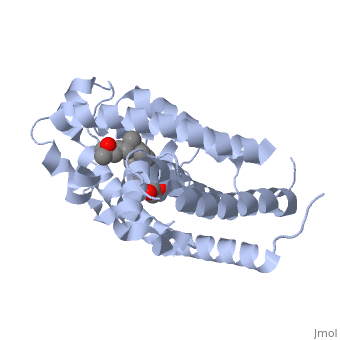Introduction
Vitamin D receptor (; also called calcitriol receptor) is a transcription factor. Upon binding to vitamin D, VDR forms a heterodimer with retinoid X receptor and binds to hormone response receptors on DNA causing gene expression. The (in green) binds to receptors in its target cells, controlling the synthesis of many different proteins involved in calcium transport and utilization. . . VDR contains two domains: a (see Nuclear receptors). that binds to the hormone (grey) and that binds to DNA. (Green and blue are two same VDR structures). It pairs up with a similar protein, 9-cis retinoic acid receptor (RXR), and together they bind to the DNA, activating synthesis in some cases and repressing it in others[1].
See also Secosteroids, Intracellular receptors, and Calcipotriol.
Disease
[VDR_HUMAN] Defects in VDR are the cause of rickets vitamin D-dependent type 2A (VDDR2A) [MIM:277440]. A disorder of vitamin D metabolism resulting in severe rickets, hypocalcemia and secondary hyperparathyroidism. Most patients have total alopecia in addition to rickets.[2][3][4][5][6][7][8][9][10][11]
Function
Vitamin D plays an essential role in regulating the levels of calcium and phosphate in the body. It is converted into a hormone that is secreted by the kidneys and travels through the body. It has major effects on intestinal cells, where it helps control the uptake of calcium, and bone cells, where it helps control the formation and maintenance of the skeleton.
[VDR_HUMAN] Nuclear hormone receptor: Transcription factor that mediates the action of vitamin D3 by controlling the expression of hormone sensitive genes. Regulates transcription of hormone sensitive genes via its association with the WINAC complex, a chromatin-remodeling complex. Recruited to promoters via its interaction with the WINAC complex subunit BAZ1B/WSTF, which mediates the interaction with acetylated histones, an essential step for VDR-promoter association. Plays a central role in calcium homeostasis.[12][13][14][15]
Mutation
In the article, "Phosphorylation of the Human Vitamin D receptor by Protein Kinase C" by Hsieh, J. et al, they presented their research on the mutation of serine to glycine and aspartic acid. They mentioned that amino acids like serine and threonine kinase plays a crucial role in signal transduction pathways drawn out by variety of growth factors, hormones, and neurotransmitters. When is mutated it is replaced with a which results in an inhibition of transcriptional activation. When transcription is inhibited it results in p53 accumulation, which activates and promotes p53 translocation into mitochondria leading to apoptosis. Transcription inhibition is useful in cancer patients and so can be used as treatment option. These are the outcomes of the mutation, with the research still in the process to find the potential cure for tumors.
is replaced with when mutated creating a negative charge. The negative charge at the residue inhibits DNA binding which cause a down – regulation of VDR activity. VDR needs DNA binding in order for it to be activated which is only possible with a serine residue. Research is still continuing to find a therapeutic cause for this mutation.
The vitamin D nuclear receptor is a ligand-dependent transcription factor that controls multiple biological responses such as cell proliferation, immune responses, and bone mineralization. Numerous 1 alpha,25(OH)(2)D(3) analogues, which exhibit low calcemic side effects and/or antitumoral properties, have been synthesized. In the article, "Structure-function relationships and crystal structures of the vitamin D receptor bound 2 alpha-methyl-(20S,23S)- and 2 alpha-methyl-(20S,23R)-epoxymethano-1 alpha,25-dihydroxyvitamin D3" by Antony, P. et al, they showed that acts as a 1alpha,25(OH)(2)D(3) superagonist and exhibits both antiproliferative and prodifferentiating properties in vitro. Using this information and on the basis of the crystal structures of human VDR ligand binding domain (hVDR LBD) bound to 1alpha,25(OH)(2)D(3), 2alpha-methyl-1alpha,25(OH)(2)D(3), or 2a, we designed a novel analogue, 2alpha-methyl-(20S,23S)-epoxymethano-1alpha,25-dihydroxyvitamin D(3) (4a), in order to increase its transactivation potency. Here, we solved the crystal structures of the hVDR LBD in complex with the 4a (C23S) and its epimer 4b (C23R) and determined their correlation with specific biological outcomes.
About this Structure
1db1 is a 1 chain structure with sequence from Homo sapiens. Full crystallographic information is available from OCA. On right hand side is Structure of human vitamin D receptor ligand-binding domain complex with vitamin D (PDB entry 1db1).
3D structures of vitamin D receptor
Vitamin D receptor 3D structures

